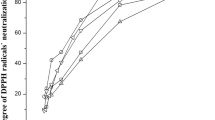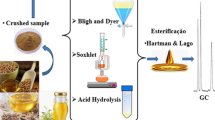Abstract
The physicochemical properties of crude Nigella seed (Nigella sativa L.) oil which was extracted using Soxhlet, Modified Bligh–Dyer and Hexane extraction methods were determined. The effect of different extraction methods which includes different parameters, such as temperature, time and solvent on the extraction yield and the physicochemical properties were investigated. The experimental results showed that temperature, different solvents and extraction time had the most significant effect on the yield of the Nigella oil extracts. The fatty acid (FA) compositions of Nigella seed oil were further analyzed by gas chromatography to compare the extraction methods. The C16:0, C18:1 and C18:2 have been identified to be the dominant fatty acids in the Nigella seed oils. However, the main triacylglycerol (TAG) was LLL followed by OLL and PLL. The FA and TAG content showed that the composition of the Nigella seed oil extracted by different methods was mostly similar, whereas relative concentration of the identified compounds were apparently different according to the extraction methods. The melting and crystallization temperatures of the oil extracted by Soxhlet were −2.54 and −55.76 °C, respectively. The general characteristics of the Nigella seed oil obtained by different extraction methods were further compared. Where the Soxhlet extraction method was considered to be the optimum process for extracting Nigella seed oil with a higher quality with respect to the other two processes.




Similar content being viewed by others
References
Ramadan MF (2007) Nutritional value, functional properties and nutraceutical applications of black cumin (Nigella sativa L.): an overview. Int J Food Sci Tech 42:1208–1218
Salem ML, Hossain MS (2000) In vivo acute depletion of CD8 (+) T cells before murine cytomegalovirus infection upregulated innate antiviral activity of natural killer cells. Int J Immunopha 22:707–718
Cheikh Rouhou S, Hentati B, Besbes S, Blecker C, Deroanne C, Attia H (2006) Chemical composition and lipid fraction characteristics of Aleppo Pine (Pinus halepensis) mill seeds cultivated in Tunisia. Food Sci Tech Int 15(5):407–416
Worthen DR, Ghosheh OA, Crooks PA (1998) The in vitro anti-tumor activity of some crude and purified components of black seed, Nigella sativa L. Antican Res 18:1527–1532
Burits M, Bucar F (2000) Antioxidant activity of Nigella sativa essential oil. Phytoth Res 14:323–328
Houghton PJ, Zarka R, de la Heras B, Hoult JRS (1995) Fixed oil of Nigella sativa and derived thymoquinone inhibit eicosanoid generation in leukocytes and membrane lipid peroxidation. Plan Med 61:33–36
Morsi NM (2000) Antimicrobial effect of crude extracts of Nigella sativa on multiple antibiotics-resistant bacteria. Acta Micr Polo 49:63–74
Atta MB (2003) Some characteristics of nigella (Nigella sativa L.) seed cultivated in Egypt and its lipid profile. Food Chem 83:63–68
Saliha B, Sipahib T, Oybak Dönmezc E (2009) Ancient nigella seeds from Boyalı Hoyuk in north-central Turkey. J Ethnopharmacol 124:416–420
Malhotra SK (2006) Nigella. In: Peter KV (ed) Handbook of herbs and spices, vol. 2. Woodhead Publishing, Cambridge
Al-Gaby AMA (1998) Amino acid composition and biological effects of supplementing broad bean and corn proteins with Nigella sativa (black cumin) cake protein. Nahrung 42:290–294
D’Antuono LF, Moretti A, Lovato AFS (2002) Seed yield, yield components, oil content and essential oil content and composition of Nigella sativa L. and Nigella damascena L. Ind Crops Prod 15:59–69
Takruri HMH, Dameh MAF (1998) Study of the nutritional value of black cumin seeds (Nigella sativa L.). J Sci Food Agric 76:404–410
Ramadan MF, Mörsel JT (2004) Oxidative stability of black cumin (Nigella sativa L.), coriander (Coriandrum sativum L.) and niger (Guizotia abyssinica Cass.) crude seed oils upon stripping. Eur J Lipid Sci Tech 106:35–43
Espin JC, Rivas CS, Wichers HJ (2000) Characterization of the total free radical scavenger capacity of vegetable oils and oil fractions using 2,2-diphenyl-1-picrylhydrazyl radical. J Agri Food Chem 48:648–656
Koski A, Psomiadou E, Tsimidou M, Hopia A, Kefalas P, Wähälä K et al (2002) Oxidative stability and minor constituents of virgin olive oil and cold-pressed rapeseed oil. Eur Food Res Tech 214:294–298
Tasioula-Margari M, Okogeri O (2001) Isolation and characterization of virgin olive oil phenolic compounds by HPLC/UV and GC–MS. J Food Sci 66:530–534
AOAC (2005) In: Firestone D (ed) Official methods of analysis of the Association of the Official Analytical Chemists. Assoc Off Anal Chem Inc, VA
Kim LL (1992) Extraction of lipids. In: Laboratory manual of analytical methods and procedures for fish and fish products, ed. Katsutoshi Miwa and Low Su Ji (eds) C-2. Singapore: Marine Fisheries Research Department, Southeast Asian Fisheries Development Center
Christie WW (1993) Preparation of ester derivatives of fatty acids for chromatographic analysis. In: Christie WW (ed) Advances in lipid methodology. Oily Press, Dundee, pp 69–111
Ghazali HM, Hamidah S, Che Man YB (1995) Enzymatic transesterification of palm olein with nonspecific and 1, 3 specific lipases. J Am Oil Chem Soc 72:633–639
AOCS (1997) Official methods and recommended practices of the American Oil Chemists’ Society, 5th edn. AOCS Press, Champaign
Dandik L, Aksoy HA (1992) The kinetics of hydrolysis of Nigella sativa (Black cumin) seed oil catalyzed by native lipase in ground seed. J Am Oil Chem Soc 69:1239–1241
Abdel-Aal ESM, Attia RS (1993) Characterization of black cumin (Nigella sativa L.) seeds. 2. Proteins. Alex Sci Exch 14:483–496
Salem MA (2001) Effect of some heat treatment on nigella seeds characteristics. 1-Some physical and chemical properties of nigella seed oil. J Agri Res, Tanta Univ. 27:471–486
Babayan VK, Koottungal D, Halaby GA (1978) Proximate analysis, fatty acid and amino acid composition of Nigella sativa L. seeds. J Food Sci 43:1315–1319
El-Dhaw ZY, Abdel-Munaem Nadia M (1996) Chemical and biological values of black cumin seeds. J Agri Sci Mansoura Univ. 21:4149–4159
Gad AM, El-Dakhakhny M, Hassan MM (1963) Studies on the chemical composition of Egyptian Nigella sativa L. Oil Plant Med 11:134–138
Üstun G, Kent LC, Ekin N, Clvelekoglu H (1990) Investigation of the technological properties of Nigella sativa (black cumin) seed oil. J Am Oil Chem Soc 67:958–960
Ramadan MF, Mörsel JT (2002) Characterization of phospholipid composition of black cumin (Nigella sativa L.) seed oil. Nah Food 46:240–244
Cheikh Rouhou S, Besbes S, Hentati B, Blecker C, Deroanne C, Attia H (2007) Nigella sativa L.: chemical composition and physico-chemical characteristics of lipid fraction. Food Chem 101:673–681
Ramadan MF, Mörsel JT (2002) Neutral lipid classes of black cumin (Nigella sativa L.) seed oils. Eur Food Res Technol 214:202–206
Author information
Authors and Affiliations
Corresponding author
About this article
Cite this article
Khoddami, A., Ghazali, H.M., Yassoralipour, A. et al. Physicochemical Characteristics of Nigella Seed (Nigella sativa L.) Oil as Affected by Different Extraction Methods. J Am Oil Chem Soc 88, 533–540 (2011). https://doi.org/10.1007/s11746-010-1687-6
Received:
Accepted:
Published:
Issue Date:
DOI: https://doi.org/10.1007/s11746-010-1687-6




